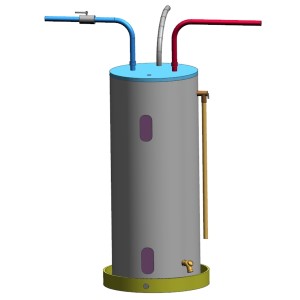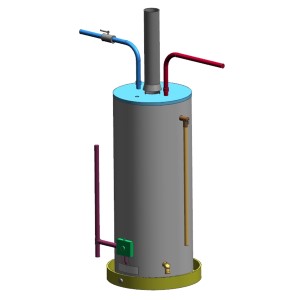- Home
- Water heater troubleshooting guide
- Fixing No Hot Water Issues
No Hot Water Issues - Troubleshooting Water Heaters
 Image source: Pixabay
Image source: PixabayFind out what to do if you have no hot water from a water heater. This troubleshooting guide is for homeowners who use a gas or electric, tankless, or tank-type water heater and experience a problem with no hot water in the shower, kitchen sink, or faucets.
Did you have a power outage or gas disruption recently? Or maybe you were trying to replace or fix some broken elements, flushing or draining?
Most of us homeowners take hot water for granted and do not realize how important it is to have it in our daily activities.
We just have to open a tap, and hot water is there. Always. We use it for washing, bathing, shower, and cooking. So what happens if there is only cold water running? Can we still take a shower, clean the dishes, and for how long?
Water heaters tend to have problems functioning correctly, whether due to leaking, overheating the water, heating the water too little, or simply not heating the water at all. When a water heater is not heating water anymore, it means there is something you need to fix or replace, so here we will talk about each of the things that could be making the water heater malfunction and how to repair it.
Whether you have a tankless or tank-type, a gas, or an electric water heater – you will always expect hot water to come down the shower, no matter the day or season. If it doesn't happen, you may be suffering from one of the problems water heaters tend to have.
Here is what you need to know about your type of water heater, its reasons for not heating water, and how to troubleshoot.
Highlights
No hot water from an electric tankless water heater
- Water temperature sensors are not working
- Electric wires are loose
- Bad heating elements
- Tripped circuit breaker
No hot water in electric water tank heaters
No hot water from a gas water tank heater
- Gas deficiency and low pressure
- Thermocouple problem
- Impurities in pilot
- Bad control valve
- Defective burners
- Venting issues
If you require professional assistance, contact your local water heater expert! Get FREE estimates here!
No hot water from an electric tankless water heater
Electric tankless water heaters are designed to heat water while it flows through the heat exchanger. There is no water storage tank, as the water is heated on demand.
As the electric units have a simpler design than gas, they are also easier to repair, even "no hot water" problem.
The "no hot water" problem in the electric water heaters doesn't require some specialized tools or experts to fix it. It should be simple to repair it even if you have common knowledge, some tools, and experience.
No matter the problem complexity, make sure that the power is being supplied to the water heater, check the circuit breaker, limit switch, thermostats, timer (if installed), and heating elements for the proper work.
Keep in mind that problems are not always related to human error or unit malfunction; they might be caused by lightning and high voltage, for example.
Taking into account the above, other common reasons when the tankless is not heating the water are:
Water temperature sensors are not working
When the temperature sensors or thermostats of the device don't work correctly, the heating process stops or not starting at all. This makes water come out of the tap/sink cold. Check the sensors or thermostats, if you can, by opening the heater.
Otherwise, contact a professional to check them out for you as the elements may need replacement.
Wires are loose
If there are loose wires, including those from sensors and heating elements, the device will not heat up the water correctly either. Open up the device while the power is turned off and check every wire and connection to make sure there is no wiring problem – locate, clean, and reconnect properly. If you can't find the wire issue, very likely, the problem is somewhere else.
Bad heating elements
Heating elements are prone to sediment and limescale buildup, preventing them from heating water fully because sediments act as the insulator.
Also, most heating elements fail over time as well – they burn out.
The solution for both of these problems is to replace the heating elements. The installation of these components can be tricky, so it is always better to contact a professional.
Tripped circuit breaker
Check the breaker on the electric panel and make sure it is switched ON, that it didn't trip. If it is OFF, simply flip it to the ON position. The water heater has its own dedicated circuit and breaker. If it happens, often call an electrician to check the circuit and connections.
No hot water in electric water tank heaters
 Tank-type electric water heater
Tank-type electric water heaterElectric water heaters with the water storage tank are also susceptible to "no hot water" problems. Some of the causes are the same as the ones found in tankless; some are different.
Shorted thermostat or heating element
The thermostats (measures temperature) and the heating elements (heat up the water) can short from time to time due to electrical problems, moisture, or foreign body. Both of these parts can be fixed only by replacing them.
Grounding or tripped breaker
Problems in wiring, electrical accidents, or objects with electrical current may cause the electric element to ground, tripped limit switch, or circuit breaker. If the limit switch has tripped, you may look for the reset button (red button) and make sure to turn it on. If the circuit breaker has tripped, switch it back on. When the device is grounded, ensure there is no current around or inside the product causing a short with wires or other parts.
Also, look for the worn wiring as it can cause wire shorts or foreign objects that could lead to accidental grounding.
Anyway, before doing any work on the electric elements, make sure to turn off the breaker. Calling a professional is always an option.
- Find Plumbers In Your Area -
Water leak
When an electrical heater has a tank or pipe leak, it might affect the proper heater operation. If it is the tank, it might need replacement as they are almost impossible to fix. For pipes, if the hole or leak is tiny, it may be adjusted. If not, replacing would be the best idea. Sometimes pipe connections just need a little tightening.
Dip tube failure
If the dip tube is broken, incoming water will go right to the hot outlet pipe without mixing first, delivering cold instead of hot water at the fixture. The only way to fix it, however, is to replace the dip tube completely. It occurs mainly in electric water heaters with tanks.
No hot water from a gas water tank heater
 Tank-type gas water heater
Tank-type gas water heaterGas water heaters are different from their electric cousins, and that is why they have different issues. If you have a gas water heater and no hot water problem, you may have some of the following issues:
Gas deficiency and low pressure
Is the gas you are using a proper type, as suggested by the manufacturer? Is the gas valve or pipe leaking? Is the pressure correct?
Or, is the gas just not reaching the burner? If you have a problem with gas and your water heater, very likely, it will not heat up. Just make sure that gas lines can transfer the gas, valves are open, and there is no leak.
Look for bent and clogged supply lines as well. Try switching off gas valves; if you smell gas after 15 minutes, very likely there is a leak.
Call a professional in this case. If there is no gas, you have a piping problem, or it may as well be the source of gas – so call the utility company.
Thermocouple problem
The thermocouple is a safety device, a part of the pilot light assembly, so when properly operating, it allows the gas valve to open so gas can flow to the pilot and gas burner. The tip of this component should always be in contact with the flame and tightened securely to the pilot light assembly. If the thermocouple is not working correctly, it has to be replaced – it cannot be fixed.
Impurities in pilot
The standing pilot should always be lit. Once the gas valve opens, the gas flows to the main gas burner, where the standing pilot lights it. If air or debris is found in the pilot pipe, very likely it won't light up or stay lit for long. Make sure you test the device several times by lighting up the burner until it fires up for more than 5 minutes. You may need to check for any impurities in the pilot and clean or replace accordingly if it does not.
Bad control valve
The gas valve is often the primary problem in most "no hot water" issues with these heaters. Sometimes these gas valves are clogged or defective, and they won't let the gas pass to the burner. These valves can't be fixed as other components, plus it is not recommended. The valves are pretty cheap to replace.
Defective burners
Burners often get clogged or dirty, and they won't merely light up correctly. Burners can be replaced very quickly if this is the case, but sometimes cleaning them up is far more straightforward.
Venting issues
Due to the insufficient combustion air delivery, when the unit is installed in the confined area, the water heater might not start. Always make sure that there is enough fresh air supplied and that the filter and flame arrestor at the base of the unit is clean.
The flame should have a blue color. If it is yellow, the room where the unit is installed needs more air supply. More about the proper flame color and shape here.
Make sure that the exhaust gases are correctly removed, and there is no blockage in the vents.
Whether it is tankless, gas, or electric water heaters – fixing can be very easy if you know where to look!
Summary
Water heating is a complicated process that requires all parts of water heaters to work as designed. Only if they operate correctly, the unit will provide plenty of hot water.
There are many reasons for the "no hot water" problem, and looking at the above troubleshooting guide, it is not hard to repair. But, sometimes, the problem is not the water heater; it can be a power outage or gas delivery issue.
Related
- Home
- Water heater troubleshooting guide
- Fixing No Hot Water Issues
